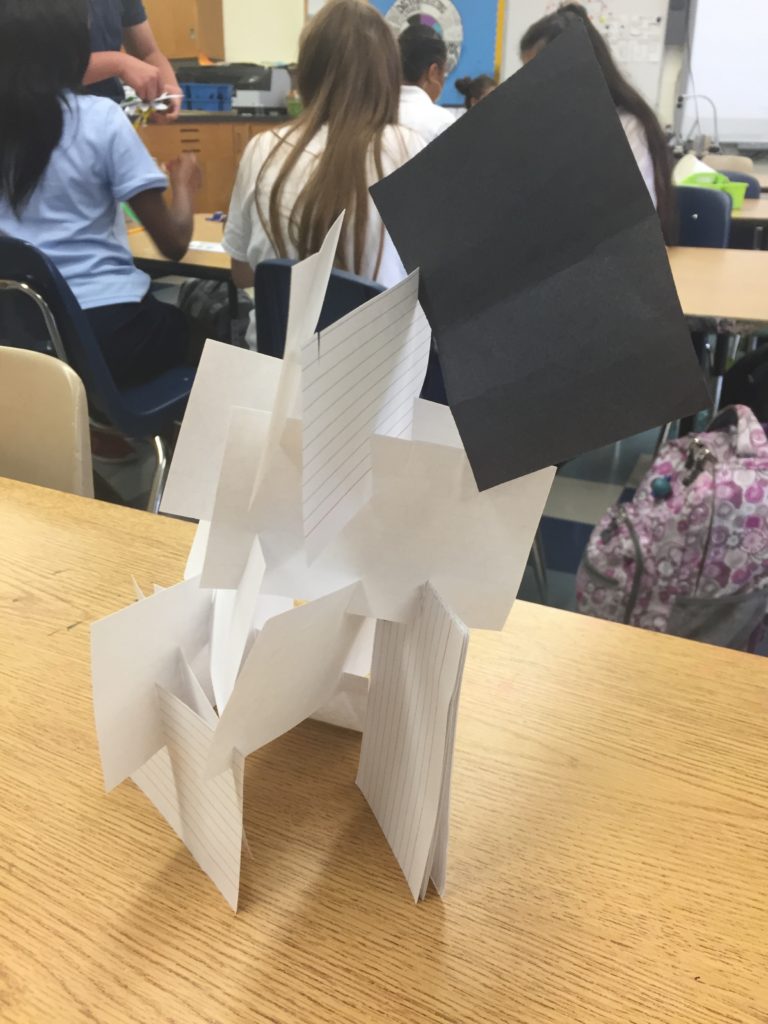design challenge
now browsing by tag
“Make It Work, Artists!” : Mini Design Challenges for the Art Room
Sunnylee Mowery, PAEA Secretary and art teacher extraordinaire at Greenfield Elementary in Philadelphia, shares her ideas on using mini “Design Challenges” to encourage collaboration and increase spontaneity between traditional lessons. Great for half days and early dismissals! Sunny shares with members her experience and provides readers with a few easy, no mess, minimal prep ideas.

The digital clock counts down! Sweat drips for the contestants’ foreheads! Expert judges lined up at a table to offer cut-throat feedback! By this point we’re all familiar with reality competition TV shows and most recently, I’m sure you’ve noticed the evolving trend of our kids creating their own idiosyncratic challenges. Epically perfect water bottle flip onto table edge, anyone? In an effort to harness the energy behind our human desire to compete, I started implementing “Mini Design Challenges” into my art curriculum and my students have responded with rave reviews!
So what is it? A design challenge is a brief, yet intriguing art prompt that students work to complete as a team. Design challenges are great for encouraging collaboration and increasing spontaneity between traditional lessons. They are a great fit for all grade levels, and demonstrate that the work of an artist isn’t just about making a masterpiece with strong elements and principles.

What I love most is that the design challenge format flips the traditional art room modus operandi on it’s head. Instead of coming to art and embarking on a personal journey of completing project objectives, I design my challenges to get kids up out of their seat and collaborating. Disclaimer: A successful design challenge may result in a room that’s louder and messier than normal! It also requires a fair share of masking tape. But for most design challenges, all you need are some recycled materials which is great for ye old budget and a boatload of fun.


I try to announce the prompt, material guidelines, and rules in less than one minute (time is of the essence!) and I make sure to provide a visual of all the parameters on the board for those that have any questions. And then boom, it’s on your mark, get set, let’s go!
Below is a list to my go-to art design challenges:
· Build a shoe out of newspaper!
· Build a table out of recycled materials that can support the weight of a dictionary.
· Create a kinetic sculpture out of 20 blank index cards.
· Create the longest line you can using only three sheets of paper and tape.
· Create a hat you would wear if you were a style icon.
· Work as a team to use each material in the “Mystery Bag” at your table to create one, complete masterpiece!
· Marshmallow Spaghetti Challenge: Using only tape and 20 piece of spaghetti, build a sculpture that support the weight of a marshmallow.

Kiddos usually get 20 minutes to complete each challenge. this chance to work as a team encourages peer to peer dialogue. Kids are forced to negotiate group troubleshooting and solve problems together on the spot. These kind of artistic endeavors help them build social skills in a low-stakes, fun oriented environment.
My favorite part of each day is the big reveal and the debrief! It’s important at the end of each design challenge to take a moment and let the students observe the way other teams solved the problem. There are so many gorgeous moments of delight and exclamations of reverie.


To prompt reflection-related dialogue, I usually wrap up with three simple questions:
· What was the easiest part of this challenge?
· What challenges did you encounter? How did you solve these?
· How did you break up the job with your teammates?
My students have come to expect four design team challenges each year. I like to throw them in on half days when classes are condensed to 30 minutes. I keep the stakes low, no one is voted off the island and no one is asked to pack their knives and go. Sometimes there are obvious “winners” and sometimes none of the teams complete the challenge prompt completely. Both results are okay. If I did a good job as a teacher, my students walk away knowing the joy of just engaging in the design process.

 D5 Creation
D5 Creation